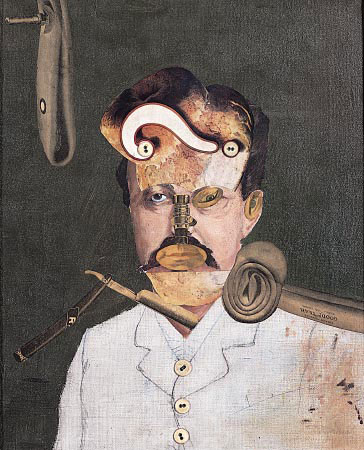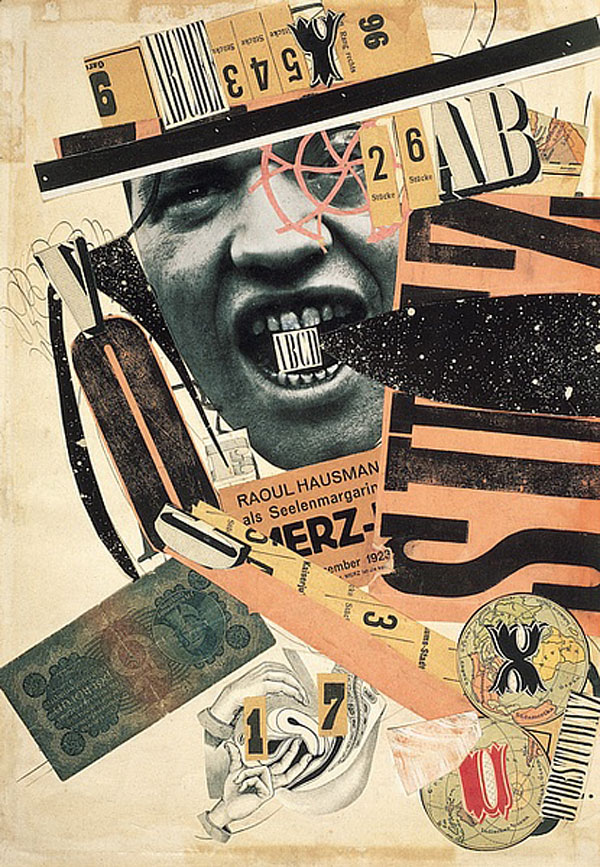Dada as just another shop, another boutique in the arcade? Dada put into question the myths surrounding originality, and the relationship of the artist to the category of “genius”. Dada suggested instead, or implied that everyone could be an artist, an almost anything could be art, such as a Duchamp urinal or bicycle wheel. It began in the Cabaret Voltaire in Zurich, Voltaire himself was hardly a revolutionary, having no sympathy whatsoever for the common man. Voltaire once write Frederick the Great, ” once the populace begins to reason, then everything is lost. I abominate the idea of government by the masses.”
Still, Surrealism, Constructivism, Guy Debord Situationism, Fluxus, Pop Art, Conceptual Art, punk rock, and Minimalism and almost all 20th century artistic movements that began after the early 1920’s have an important connection to Dada, through the permeation of non-aesthetic content. Dada art still possesses a radicality and form of novelty attractive to culture jammers like Adbusters and those seeking to rupture the rhythms of life as usual. In terms of its nihilism, for the most part gratuitous and not connected to a more profound spiritual or messianic basis, the question of its honesty and artistic integrity can be questioned.

---In "Dadaist Disgust," in the final section of his Dada Manifesto (1918) (the argument begins with a section titled "Dada Means Nothing"), the poet Tristan Tzara stated that Dada is "a protest with the fists of its whole being engaged in destructive action." "Every product of disgust capable of becoming a negation... is Dada," he declared. Tzara’s rabid negativism re-appeared two years later in Francis Picabia’s Dada Manifesto, which, after trashing Cubism -- "cubed paintings of the primitives, cubed Negro sculptures, cubed violins, cubed guitars, cubed the illustrated papers, cubed shit," all designed to "cube money" -- declared that "Dada itself wants nothing, nothing, nothing, it’s doing something so that the public can say: ‘We understand nothing, nothing, nothing.’" Picabia, who said he "knows nothing, nothing, nothing," declared that "the Dadaists... will come to nothing, nothing, nothing." It is "farce, farce, farce, farce, farce." It is hard to find a more consummate statement of nihilism -- what Richard Huelsenbeck, one of the first Dadaists, called Dada’s "nihilism and its love of paradox"(3) -- in the history of avant-garde art.---Read More:http://www.artnet.com/magazineus/features/kuspit/kuspit2-17-06.asp image:http://heyokamagazine.com/HEYOKA.2.PAINT.GROZ.htm
“Is Dadaism as sign and gesture the opposite of Bolshevism?” Ball asks in his diary on June 7, 1917. “Strange incidents: when we had the Cabaret Voltaire in Zurich at Spiegelgasse , there lived at Spiegelgasse 6, opposite us, if I am not mistaken, Mr. Ulyanov-Lenin.” A year and a half later in Bern, Ball meets Walter Benjamin, whom he introduces to Ernst Bloch, newly author of The Spirit of Utopia (1918). Benjamin is very impressed by Bloch; at this point his scales of history still tilt in favor of hope. Several years later, at the end of “One-Way Street (1923–26),a textual montage that works to relay, through imagistic vignettes and abrupt cuts,the shock experiences of industrial war and mediated metropolis, Benjaminwrites: “In the nights of annihilation of the last war, the frame of mankind wasshaken by a feeling that resembled the bliss of the epileptic. And the revolts that followed it were the first attempt of mankind to bring the new boy under its control. The power of the proletariat is the measure of its convalescence.” …

---Walter Benjamin recognized the importance of Dada when he wrote in 'The Work of Art in the Age of Mechanical Reproduction' that when authenticity ceases to be an important part of making art, "the total function of art is reversed. Instead of being based on ritual it begins to be based on another practice, politics." ---Image:http://www.johnvalentino.com/Teaching/Art190/Projects/190Proj2/Dada.html
But “mankind” doesn’t get well: the proletariat is soon contained in Germany and disciplined in the Soviet Union, as its “shaking” is brought under different dictatorial control. Perhaps this suppression is one reason why the Dadaist miming of “the bliss of the epileptic,” first enacted by Ball in his performance, willrecurintermittently, variously, compulsively for decades to come. Read More:http://www.scribd.com/doc/50596411/dada-mime
Benjamin identified in the self-conscious destructive barbarism of Dada a staging of the imminent obsolesence of art before technology, which he observed paradoxically, “works toward a certain form of art.” ( Caygill) Benjamin called this the relentless destruction of the aura of their creations while remaining within the compass of the traditional definitions of art.

Kuspit:There’s an intimate connection between the spiritualism and the nihilism that emerged in the avant-garde art of the second decade of the twentieth century – that’s the thesis I want to propound in this chapter. The two great innovations of the decade are abstract art and Dadaism, which hardly seem to have anything to do with each other. The former is fraught with spiritual aspirations that make it seem more than art, while the latter is nihilistic to the extent that it doesn’t seem to be art, or else is art only in an ironic sense, or, as it came to be thought of, "Novelty Art" and, finally, "anti-art." But there is a strong streak of nihilism -- anarchistic alienation -- in spiritual abstract art. And there is a certain reluctant, ironic -- one might say unsentimental -- spirituality in Dadaism, underneath its belligerence, which often seems like a pose, a calculated acting out....Read More:http://www.artnet.com/magazineus/features/kuspit/kuspit2-17-06.asp image:http://www.johnvalentino.com/Teaching/Art190/Projects/190Proj2/Dada.html
The art that happened to them, the shock or disruptive quality, thus acquired a tactile quality. Yet for Benjamin this shock, while anticipating the effect of film, did not share its cathartic potential. This is because dada, like cubism or futurism, remained within the “wrappers” or confines of art. All of these movements were judged by Benjamin to be the deficient attempts of art to accommodate the pervasion of reality by the technical apparatus. ( Caygill)… It was a representation within art of the effects of the transformation of experience by technology, such as “shock” in the case of Dada, the transformation of “space” in cubism and “speed” in futurism….
ADDENDUM:
If not the opposite of Bolshevism, Dada does propose a “new man” very different from that of avant-garde artists in revolutionary Russia. The Dadaist “bachelor machine” figures a reification that proceeds from capitalist industry tothe individual; the Constructivist “engineer” personifies a rationalization that runs from the individual to communist society at large. “On the one hand a totteringworld in flight, betrothed to the glockenspiel [chimes] of hell,” Tristan Tzara writes in “Dada Manifesto 1918”; “on the other hand: new men.” Here Tzara seems togloss another Dadaist account of “Der neue Mensch” by Richard Huelsenbeck published in Neue Jugend on May 23, 1917, nearly a year after the Ball performance,an account in which the tottering and the new are one:The new man stretches wide the wings of his soul, he orients his inner ear toward things to come, his knees find an altar before which to bend. Hecarries pandemonium within himself, the pandemonium naturae ignotae Read More:http://www.scribd.com/doc/50596411/dada-mime

Miles W. Mathis:Max Ernst’s The Hat Makes the Man is another very clear example. There is nothing here that could be mistaken for aesthetics. Warhol’s Where’s Your Rupture is basically just a reworking of this nullity, where a stupid advertisement stands as the artist’s entry in the most meaningless thing imaginable category. Why seek the most meaningless thing imaginable? To take the most wind out of those who seek meaning. Ernst says, “I am rich and famous and happy and clever by giving the world works like this. Why then seek meaning and beauty and depth? Your only reward will be a severed ear or abuse from the burghers.” Read More:http://mileswmathis.com/moma.html
Kuspit:Apart from nothing, what did Dada offer? The “abolition of logic,” as Tzara said, and its replacement by “spontaneity.” Dadaism officially began in February 1916 with the founding in Zürich of the Cabaret Voltaire by Hugo Ball, a poet and philosopher, and Emily Hennings, a nightclub entertainer.
They were in neutral Switzerland, and undisturbed by the war. Is that why they could be spontaneous? Here is an example of their spontaneity: Ball played the piano, Huelsenbeck beat on a drum, and Tzara wiggled his bottom, presumably in the audience’s face. “We want to shit in different colors to adorn the zoo of art,” he wrote; presumably this was his way of doing so.
Sometimes Huelsenbeck would “roar my lungs out, more like a sideshow barker than a reciter of verse, and wave my cane about in the air. The spectators saw me as an arrogant and utterly belligerent young man,” he wrote. “Other performances featured raucous noises, simultaneous readings of poems in several languages (or no known language), African chants, jazz songs, dances, shouts and anything else that would outrage public opinion. Dada painter and historian Hans Richter put it this way: ‘The devising and raising of public hell was an essential function of any Dada movement, whether its goal was pro-art, non-art, or anti-art. And when the public, like insects or bacteria, had developed immunity to one kind of poison, we had to think of another…. It seemed to me the Swiss authorities were much more suspicious of Dadaists, who were all capable of performing some new enormity at any moment, than of [the] quiet, studious Russians” — Vladimir Lenin lived near the Cabaret Voltaire — who were soon to lead the Russian Revolution.
Spontaneity, then, meant offending the public and disturbing the peace — the peculiarly artificial, stilted peace of a neutral country surrounded by countries vigorously at war. But it also meant rebellion against social, political and artistic propriety and authority: Decorum was replaced by confrontation, entertainment meant transgression. All that was cherished as civilized was now mocked and challenged. Indeed, nothing sacred was out of bounds; all that European civilization held sacred was fair game, because European countries had betrayed the social contract — a sacred trust — by going to war. Read More:http://www.artnet.com/magazineus/features/kuspit/kuspit2-17-06.asp





 COMMENTS
COMMENTS